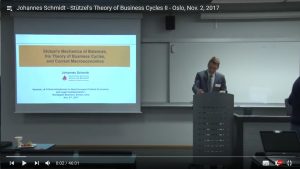The fourth presentation at our seminar at BI Norwegian Business School is online: Johannes Schmidt presents, for the first time in english, Part II of Stützel’s theory of business cycles.
Stützel’s simple general approach solves a number of recurring controversies in monetary economics – especially that of a coherent integration of the “real” and “monetary” or “nominal” spheres – and provides a general theory within which existing business cycle theories – both “monetary” and “nonmonetary” – can be integrated as special cases.
It is based on nothing more than standard business and national double entry accounting categories – plus one original concept (“Lockstep” of inflows/outflows of net financial assets and/or means of payment), which is the core concept of Schmidt’s talk.
With the lockstep concept, Stützel demonstrates in a simple way why in models that implicitly presuppose lockstep – such as the Walrasian general equilibrium model or today’s “real business cycle” models – money naturally cannot “matter” (Hahn’s Problem), whereas in Keynesian and post keynesian monetary production models, this is partially remedied as explicitly intended by Keynes, but still lacks the necessary precision and clarity. This precision, however, can be taken simply from empirical (business and national) accounting practice: the distinction between means of payment and net financial assets. Stützel imported this precision into ex ante macro theory as the “bipartite division of the theory of money”, added the lockstep concept and showed (already in 1953) that existing theories can be seen as describing special cases within that general framework. Johannes Schmidt applies this to today’s macroeconomic theories of business cycles.

